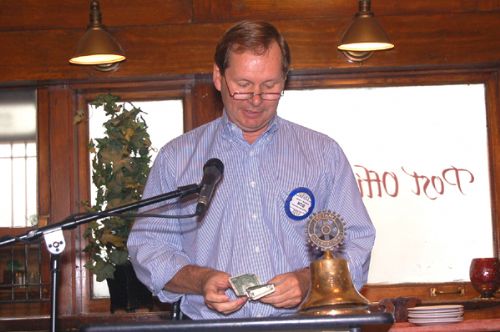Cogitator 090729
Our visiting Rotarian this week was Bob Haig from Warwick.
Our Guests were former club members Vito Vitone and Mike Westerman.
Mike Neville and Bob Petrucelli have wedding anniversaries and Gill Thorpe and Bob MacKenzie are celebrating birthdays. Gill was not present, but with the announcement of Bob's Birthday the club broke into song. Unfortunately they were all signing different songs and it was a few minutes until they all joined in Happy Birthday. Taken aback by this outburst of affection for his leadership skills, President MacKenzie fished a dollar from his bulging money clip.
Phonebook, phonebook, phonebook..wrap it up. Chairperson Jonathon Widmark says we have only 35 ads outstanding and are within $8,000 of our goal. Alan Clarke, who does the layout work for us, is ready to go next week, which should put us on schedule to get to the printer by September and deliver the book the first week of October. Great job by the club so far. Clean up those final ads. You can report your results to Richard Waterman, or drop off your paperwork at the Chamber of Commerce office at 580 Main Street.
President Bob reported attending a Scholarship Committee meeting and was surprised to learn most of the members were not high school graduates. He urged them to follow his example and work on their GEDs. The committee has been conservative in their approach, and with the help of their financial advisor managed to avoid losses as large as some investors have experienced. The fund balance is only down about 12%, with a total of some $230,000. There may be some adjustment in the next awards, depending on the future of the market. The club gave the committee a rousing round of applause for their hard work.
Best in Rhode Island. Richard Waterman reported his company's Orla Soy Candles won a Best Of award in the Rhode Island Monthly magazines annual competition. In honor of the award Richard went to the Baptist Church to light a candle. Jonathon said he wasn't sure, but didn't believe that was a Baptist tradition, and sent Richard over to see Amy. The last we heard they were still trying to figure it out.
CASH FOR CLUNKERS.
Bob Miller paid a $1.00 fine to advertise his Clunker 2005 BMW which he wants to get rid of so he can buy the car of his dreams, a Mustang convertible. Bob told how he had wanted a Mustang when he got married, but the birth of twins forced him to buy a station wagon. He has been saving pennies all these years and finally has enough for the Mustang. His story set of a spate of Mustang stories we didn't really want to hear, but couldn't stop. The conclusion of this story is that Bob MacKenzie was very interested in the BMW and made an offer. Miller said the car is in good shape, and was only drive on weekends at the Seekonk Speedway.
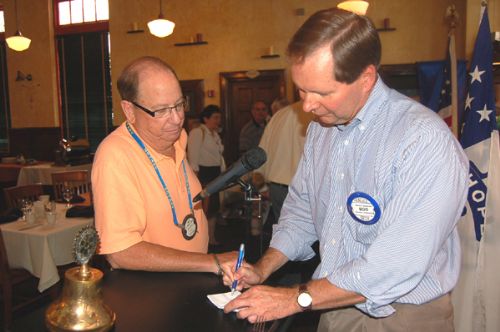
Sabrina Pacheco, our Rotary Youth Exchange Student, gave us an update on her trip to Pamplona, Spain. While there, she stayed with the family of student Itaso Lorinay, who is now here for her part of the exchange. Sabrina presented a great powerpoint of photos of her trip. Ed Neff said the visit for Itaso would include a visit to Washington DC, New York City and Boston, among other stops.
In the pictures Sabrina displays the bandanas worn during the festival and the official program.
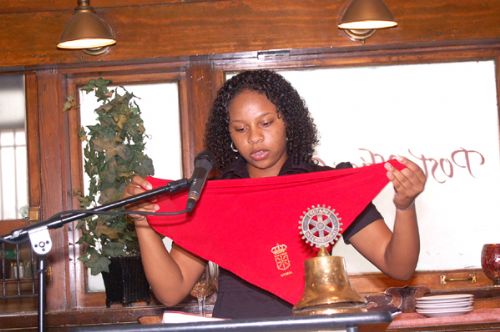
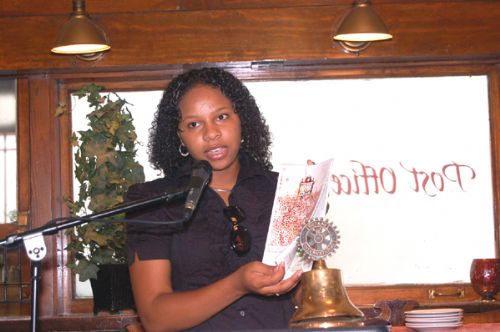
Sabrina was in Pamplona during the running of the bulls. Below are pictures of the bulls and the
story of how the Running of the Bulls came about.
History of the Pamplona Bull Run
The
festival of San Fermin, or the Pamplona bull running as it's more
commonly known outside Spain officially begins at midday on 6th July
every year with the 'chupinazo' which takes place on the balcony of the
Casa Consistorial in Pamplona. Thousands of people congregate in the
square awaiting the mayor's official announcement that the fiestas have
begun, a rocket is launched and the partying begins.
The history
of the bullrunning in Pamplona is not clear. There is evidence of the
festival from as far back as the 13th century when it seems the events
took place in October as this coincided with the festival of San Fermin
on October 10th. It seems that the modern day celebration has evolved
from this as well as individual commercial and bullfighting fiestas
which can be traced back to the 14th century.
Over many years
the mainly religious festival of San Fermin was diluted by music,
dancing, bullfights and markets such that the Pamplona Council proposed
that the whole event be moved to July 7th when the weather is far more
conducive to such a celebration. To this day San Fermin remains a fixed
date every year with the first bullrun at 8am on July 7th and the last
at the same time on July 14th.

|

|
The joining together of the religious, commercial and bullfighting festivals and the move to July 7th led to the first official celebration of San Fermines in 1591. This inaugural fiesta was a low key affair in comparison to the modern day running of the bulls as it only lasted two days although there was much merriment involving music, a procession and a bullfight. dancing and fireworks became features of the festival over the next few years and the evnt was extended to July 10th.
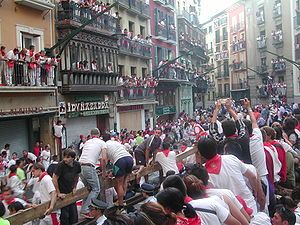
.png)

